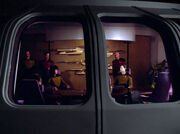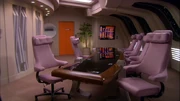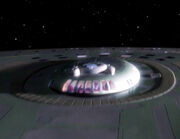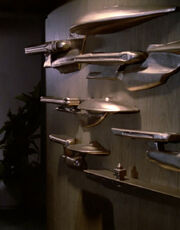m (→USS Enterprise-D: replaced a word) |
(+more bg info) |
||
| Line 3: | Line 3: | ||
On both the ''Galaxy''- and ''Sovereign''-classes, the room was elongated, spanned the entire area aft of the [[bridge]] on Deck 1 and featured a large conference table. There was also a series of seven viewports, composed of [[transparent aluminum]]. ({{TNG|In Theory}}) These viewports spanned from close to the floor to up along the angled ceiling, which faced the rear of the ship. ({{TNG|Lonely Among Us}}) |
On both the ''Galaxy''- and ''Sovereign''-classes, the room was elongated, spanned the entire area aft of the [[bridge]] on Deck 1 and featured a large conference table. There was also a series of seven viewports, composed of [[transparent aluminum]]. ({{TNG|In Theory}}) These viewports spanned from close to the floor to up along the angled ceiling, which faced the rear of the ship. ({{TNG|Lonely Among Us}}) |
||
| − | {{bginfo|The concept of the observation lounge, complete with its big conference table, was initiated after [[Gene Roddenberry]] suggested that the ''Galaxy''-class bridge include a large oval table and be essentially a conference room, an idea that was deemed as lacking dramatic excitement. ({{STTM|2|12}}, p. 22)|The |
+ | {{bginfo|The concept of the observation lounge, complete with its big conference table, was initiated after [[Gene Roddenberry]] suggested that the ''Galaxy''-class bridge include a large oval table and be essentially a conference room, an idea that was deemed as lacking dramatic excitement. ({{STTM|2|12}}, p. 22)|The observation lounge was originally termed a "ready room". This was at a time, during preproduction of ''[[Star Trek: The Next Generation]]'', when that set was named the "away cabin". (''[[Star Trek: The Next Generation Companion]]'' 3rd ed., p. 21)|The windows from TNG's observation lounge were reused for the equivalent area seen in {{film|8}} and {{film|10}}, as well as the potential [[Ten Forward]] seen in {{film|9}}.}} |
== ''Galaxy''-class == |
== ''Galaxy''-class == |
||
| Line 14: | Line 14: | ||
===USS ''Enterprise''-D=== |
===USS ''Enterprise''-D=== |
||
For a number of years, the wall opposite the windows on the {{USS|Enterprise|NCC-1701-D|-D}} featured an {{w|Relief|alto-relievo}}-style display of scale sculptures of six of the Earth vessels previously commissioned as the USS ''Enterprise'' as of [[2364]]. ({{TNG|Encounter at Farpoint}}) This display was removed, for unspecified reasons, in [[2368]]. Also at this time, ribbed light vents were added below the windows. ({{TNG|Redemption II|Darmok}}) |
For a number of years, the wall opposite the windows on the {{USS|Enterprise|NCC-1701-D|-D}} featured an {{w|Relief|alto-relievo}}-style display of scale sculptures of six of the Earth vessels previously commissioned as the USS ''Enterprise'' as of [[2364]]. ({{TNG|Encounter at Farpoint}}) This display was removed, for unspecified reasons, in [[2368]]. Also at this time, ribbed light vents were added below the windows. ({{TNG|Redemption II|Darmok}}) |
||
| − | {{bginfo|[[Ronald D. Moore]] has implied that these ships are now in his possession. {{AOLchat|Ronald D. Moore|ron017|1997}}}} |
+ | {{bginfo|The display of USS ''Enterprise'' sculptures echoes a memorial on the [[recreation deck]] of the {{USS|Enterprise|NCC-1701}}, as depicted in {{film|1}}. Each of the sculptures was created with fiberglass-covered foam. (''[[Star Trek: The Next Generation Companion]]'' 3rd ed., p. 21) [[Ronald D. Moore]] has implied that these ships are now in his possession. {{AOLchat|Ronald D. Moore|ron017|1997}}}} |
In [[2369]], the display screens were permanently illuminated, with the port display showing information about the ''Enterprise'' systems and the starboard display giving status reports of various [[Starfleet]] vessels. ({{TNG|Chain of Command, Part I}}) |
In [[2369]], the display screens were permanently illuminated, with the port display showing information about the ''Enterprise'' systems and the starboard display giving status reports of various [[Starfleet]] vessels. ({{TNG|Chain of Command, Part I}}) |
||
Revision as of 01:37, 20 January 2013

A darkened Galaxy-class observation lounge in 2364, as seen from space
The observation lounge or conference lounge was a special designation referring to the briefing room on Galaxy- and Template:ShipClass starships. The room was used as a meeting place for the ship's senior staff as well as special events and gatherings. Some went to the observation lounge simply for the view. Admiral Jameson usually found himself in the ship's observation lounge, looking out at the stars, just prior to a mission. (TNG: "Encounter at Farpoint", "Chain of Command, Part I", "Too Short a Season"; Star Trek Nemesis)
On both the Galaxy- and Sovereign-classes, the room was elongated, spanned the entire area aft of the bridge on Deck 1 and featured a large conference table. There was also a series of seven viewports, composed of transparent aluminum. (TNG: "In Theory") These viewports spanned from close to the floor to up along the angled ceiling, which faced the rear of the ship. (TNG: "Lonely Among Us")
Galaxy-class
A Galaxy-class observation lounge in 2367

A Galaxy-class observation lounge in 2370

An exterior view

The USS Enterprise historical sculpture display on the USS Enterprise-D
The observation lounge on the Galaxy-class was connected to the bridge through a short, ramped corridor, which originated at the upper starboard alcove of the bridge and led to a door on the starboard side of the conference lounge. Another door, on the port side of the room, led to another corridor, (TNG: "Datalore") at the end of which was a turbolift. The shape of the conference table matched the curvature of the exterior hull, and had seating and data pads for ten individuals. The captain usually sat at the head of the table, at either side. In 2365, two display screens were added and located at either side of the room, behind the table and adjacent to the doors. The observation lounge was decorated by plants, and had two replicator terminals. (TNG: "The Child")
USS Enterprise-D
For a number of years, the wall opposite the windows on the USS Enterprise-D featured an alto-relievo-style display of scale sculptures of six of the Earth vessels previously commissioned as the USS Enterprise as of 2364. (TNG: "Encounter at Farpoint") This display was removed, for unspecified reasons, in 2368. Also at this time, ribbed light vents were added below the windows. (TNG: "Redemption II", "Darmok")
In 2369, the display screens were permanently illuminated, with the port display showing information about the Enterprise systems and the starboard display giving status reports of various Starfleet vessels. (TNG: "Chain of Command, Part I")
The conference lounge served a multitude of purposes; in addition to being a meeting place, it could also host informal parties (TNG: "The Game") and held events for "Captain Picard Day." (TNG: "The Pegasus")
In late 2367, the observation lounge was decompressed after the transparent aluminum of a window was temporarily phased out of normal space by pockets of subspace instability in a dark matter nebula. (TNG: "In Theory")
In 2370, effects due to the D'Arsay archive transformed the observation lounge into a swamp. (TNG: "Masks")
Sovereign-class

A Sovereign-class observation lounge

The Enterprise models in 2373

The Enterprise models and master systems display in 2379
The layout of the Sovereign-class observation lounge was similar to that of the Galaxy-class; the conference table was curved in a similar manner, and there was also the same number of seats. However, the room connected directly to the bridge via two doors on either side of the master systems display. Steps inside the lounge led down to the table level. The room also lacked viewscreens during the early 2370s.
USS Enterprise-E
In 2373, the USS Enterprise-E conference lounge also had a "past Enterprises" display, though it took the form of a large glass case enclosing seven full models on stands (the Enterprise-D being the most recent). The display was damaged when Captain Jean-Luc Picard smashed the case with a phaser rifle in a fit of hysteria following an attack from his one-time abductors, the Borg. (Star Trek: First Contact)
By 2379, the case was split to either side of a new, large computer terminal and the doors were relocated. (Star Trek Nemesis)
